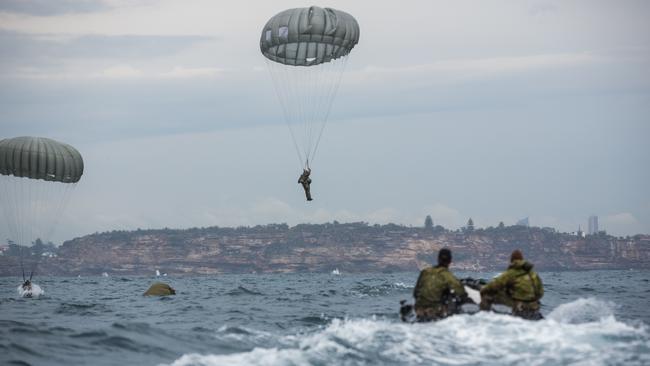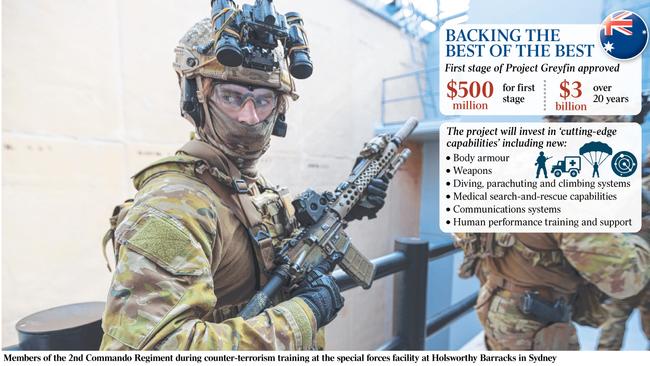SAS fighting funds to be increased by billions
Australia’s special forces will be boosted under a $3 billion, 20-year program.

The ability of Australia’s special forces to rapidly and covertly deal with security threats in the Indo-Pacific will be boosted with new hi-tech equipment, including drones, weapons and communications systems, under a $3 billion, 20-year program to cement their position as the region’s most potent fighting force.
The Morrison government has approved the first stage of Project Greyfin, green-lighting $500 million in new spending over the next four years to ensure the elite combat units continue to have access to the best intelligence, science and technology.
The project will over time lift the operational capabilities of Australian special forces towards those of the US Navy SEALs and Delta Force, which can be deployed anywhere in the world within 24 hours to complete sensitive, high-stakes missions, and be returned safely home again.

Scott Morrison, who will officially announce the new investment today, said ensuring the Special Air Services and 2nd Commando regiments had access to leading-edge technology would enable them to better respond to threats, including terrorism.
“Global threats will continue to evolve. This funding will ensure our special forces have cutting-edge capabilities to stay ahead of those who might threaten Australia’s interests,” the Prime Minister said.
The investment comes amid growing tensions in the Indo-Pacific, with Australia and the US calling out China last week over “coercive” conduct in the South China Sea, including the militarisation of disputed islands and “disruptive activities” targeting oil and gas projects, and international fishing.
Alarm bells have also been sounded over the development of a possible Chinese base in Cambodia, while in Australia’s immediate region, the upcoming Bougainville independence referendum will also be closely watched as a potential flashpoint.
Project Greyfin includes the procurement of new combat systems, unmanned vehicles, body armour, weapons, diving technology and communications equipment. New parachuting systems to deploy soldiers and combat equipment, medical technology, and human performance training, will also be made available to the nation’s most highly trained fighters.
The upgraded kit will be supplemented by up to 16 special operations support helicopters already announced by the ADF for delivery in 2022, after they were identified as a priority in the 2016 Defence white paper.
Australia’s SAS and 2nd Commando operators are considered to be “pound for pound” as able as their US counterparts, and those of Britain’s SAS.
However, Australian special forces are said to trail those of the US and Britain in intelligence, surveillance and reconnaissance capabilities, and their ability to project force rapidly over long distances.
Liberal MP Andrew Hastie, a former SAS officer and chairman of the parliamentary joint committee on intelligence and security, said lifting the capabilities of the nation’s special forces regiments would enable them to deliver “clandestine, discreet strategic effects” to protect the national interest.
Bolstering the SAS and Commando regiments’ equipment and technological capabilities would build “discreet insertion and extraction capabilities for our force elements”, Mr Hastie said.
He said cutting-edge technology supported the special forces’ intelligence and surveillance capabilities, “so drones are a big part of it”.
The ability to project Australian force quickly and quietly into the region was also key, he said.
“We need the ability to respond rapidly to an evolving situation in the Indo-Pacific by sending a discreet force element to secure our interests.
Mr Hastie described the special forces as “the entrepreneurial wing of the ADF”.
“It’s their job to disrupt — special operators achieve relative superiority in a fight by using asymmetric means,” he said.
“You get bang for buck because they constantly innovate and look for the next technological ridge line. That benefits the larger ADF and interagency environment.”
He said US special forces were renowned for their force projection and covert capabilities.
“The Americans are able to do that because they can pack up special operation capability, deploy it on the other side of the world within in 18-24 hours, do a job, and then bring it back again. “They integrate air, naval, intelligence and space capabilities to deliver a joint strategic effect.”
Defence Minister Linda Reynolds said Project Greyfin was part of the biggest peacetime investment in Defence, restoring defence spending to 2 per cent of GDP — a benchmark cited by Donald Trump as a requirement of US allies.
“Our special forces, now more than ever, need to be ready and able to deploy on operations anywhere in the world, at short notice, and in very uncertain conditions,” Senator Reynolds said.
“This first stage of funding enables our special forces to engage with intelligence, science and technology, and innovation organisations to ensure future threats and opportunities are assessed, to make sure we are delivering them the capability they need in the future.”
The new special forces helicopters will be able to be rapidly deployed in C-17 transport aircraft.
They will “insert, extract and provide fire support for small teams of Special Forces undertaking tasks ranging from tactical observation through to counter-terrorism missions, or hostage recovery”.




To join the conversation, please log in. Don't have an account? Register
Join the conversation, you are commenting as Logout